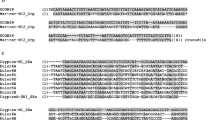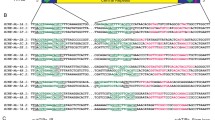Summary
All modern mammals contain a distinctive, highly repeated (⩾50,000 members) family of long interspersed repeated DNA called the L1 (LINE 1) family. While the modern L1 families were derived from a common ancestor that predated the mammalian radiation ∼80 million years ago, most of the members of these families were generated within the last 5 million years. However, recently we demonstrated that modern murine (Old World rats and mice) genomes share an older long interspersed repeated DNA family that we called Lx. Here we report our analysis of the DNA sequence of Lx family members and the relationship of this family to the modern L1 families in mouse and rat. The extent of DNA sequence divergence between Lx members indicates that the Lx amplification occurred about 12 million years ago, around the time of the murine radiation. Parsimony analysis revealed that Lx elements were ancestral to both the modern rat and mouse L1 families. However, we found that few if any of the evolutionary intermediates between the Lx and the modern L1 families were extensively amplified. Because the modern L1 families have evolved under selective pressure, the evolutionary intermediates must have been capable of replication. Therefore, replicationcompetent L1 elements can reside in genomes without undergoing extensive amplification. We discuss the bearing of our findings on the evolution of L1 DNA elements and the mammalian genome.
Similar content being viewed by others
References
Adey NB, Comer MB, Edgell MH, Hutchison CA III (1991) Nucleotide sequence of a mouse full-length F-type L1 element. Nucleic Acids Res 19:2497
Ausubel FM, Brent R, Kingston RE, Moore DD, Seidman JG, Smith JA (1989) Current protocols in molecular biology. John Wiley & Sons, New York
Britten RJ, Baron WF, Stout DB, Davidson EH (1988) Sources and evolution of human Alu repeated sequences. Proc Natl Acad Sci USA 85:4770–4774
Burton FH, Loeb DD, Voliva CF, Martin SL, Edgell MH, Hutchison CA III (1986) Conservation throughout mammalia and extensive protein-encoding capacity of the highly repeated DNA long interspersed sequence one. J Mol Biol 187:291–304
Casavant NC, Hardies SC, Funk FD, Comer MB, Edgell MH, Hutchison CA III (1988) Extensive movement of LINES ONE sequences in beta-globin loci of Mus caroli and Mus domesticus. Mol Cell Biol 8:4669–4674
Catzeflis FM, Sheldon FH, Ahlquist JE, Sibley CG (1987) DNA-DNA hybridization evidence of the rapid rate of muroid rodent DNA evolution. Mol Biol Evol 4:242–253
D'Ambrosio E, Waitzkin SD, Witney FR, Salemme A, Furano AV (1986) Structure of the highly repeated, long interspersed DNA family (LINE or L1Rn) of the rat. Mol Cell Biol 6:411–424
Deininger PL, Daniels GR (1986) The recent evolution of mammalian repetitive DNA elements. Trends Genet 2:76–80
Devereux J, Haeberli P, Smithies O (1984) A comprehensive set of sequence analysis programs for the VAX. Nucleic Acids Res 387–395
Dombroski BA, Mathias SL, Nanthakumar E, Scott AF, Kazazian HJ (1991) Isolation of an active human transposable element. Science 254:1805–1808
Fanning TG (1983) Size and structure of the highly repetitive BAM HI element in mice. Nucleic Acids Res 11:5073–5091
Furano AV, Robb SM, Robb FT (1988) The structure of the regulatory region of the rat L1 (L1Rn, long interspersed repeated) DNA family of transposable elements. Nucleic Acids Res 16:9215–9231
Gebhard W, Meitinger T, Hochtl J, Zachau HG (1982) A new family of interspersed repetitive DNA sequences in the mouse genome. J Mol Biol 157:453–471
Gojobori T, Li W-H, Graur D (1982) Patterns of nucleotide substitution in pseudogenes and functional genes. J Mol Evol 18:360–369
Gojobori T, Moriyama EN, Kimura M (1990) Statistical methods for estimating sequence divergence. Methods Enzymol 183:531–550
Hardies SC, Martin SL, Voliva CF, Hutchison CA III, Edgell MH (1986) An analysis of replacement and synonymous changes in the rodent L1 repeat family. Mol Biol Evol 3:109–125
Hattori M, Hidaka S, Sakaki Y (1985) Sequence analysis of a KpnI family member near the 3′ end of human β-globin gene. Nucleic Acids Res 13:7813–7827
Hattori M, Kuhara S, Takenaka O, Sakaki Y (1986) L1 family of repetitive DNA sequences in primates may be derived from a sequence encoding a reverse transcriptase-related protein. Nature 321:625–628
Jansen R, Ledley FD (1990). Disruption of phase during PCR amplification and cloning of heterozygous target sequences. Nucleic Acids Res 18:5153–5156
Jurka J, Smith T (1988) A fundamental division in the Alu family of repeated sequences. Proc Natl Acad Sci USA 85:4775–4778
Kazazian HHJ, Wong C, Youssoufian H, Scott AF, Phillips DG, Antonarakis SE (1988) Haemophilia A resulting from de novo insertion of L1 sequences represents a novel mechanism for mutation in man. Nature 332:164–166
Li W-H, Tanimura M, Sharp PM (1987) An evaluation of the molecular clock hypothesis using mammalian DNA sequence. J Mol Evol 25:330–342
Li W-H, Wu C-I, Luo C-C (1984) Nonrandomness of point mutation as reflected in nucleotide substitutions in pseudogenes and its evolutionary implications. J Mol Evol 21:58–71
Loeb DD, Padgett RW, Hardies SC, Shehee WR, Comer MB, Edgell MH, Hutchison CA III (1986) The sequence of a large L1Md element reveals a tandemly repeated 5′ end and several features found in retrotransposons. Mol Cell Biol 6:168–182
Martin SL, Voliva CF, Burton FH, Edgell MH, Hutchison CA III (1984) A large interspersed repeat found in mouse DNA contains a long open reading frame that evolves as if it encodes a protein. Proc Natl Acad Sci USA 81:2308–2312
Martin SL, Voliva CF, Hardies SC, Edgell MH, Hutchison CA III (1985) Tempo and mode of concerted evolution in the L1 repeat family of mice. Mol Biol Evol 2:127–140
Mathias SL, Scott AF, Kazazian HJ, Boeke JD, Gabriel A (1991) Reverse transcriptase encoded by a human transposable element. Science 254:1808–1810
Morse B, Rotherg PG, South VJ, Spandorfer JM, Astrin SM (1988) Insertional mutagenesis of the myc locus by a LINE-1 sequence in a human breast carcinoma. Nature 333:87–90
Nur I, Pascale E, Furano AV (1988) The left end of rat L1 (L1Rn, long interspersed repeated) DNA which is a CpG island can function as a promoter. Nucleic Acids Res 16:9233–9251
Pascale E, Valle E, Furano AV (1990) Amplification of an ancestral mammalian L1 family of long interspersed repeated DNA occurred just before the murine radiation. Proc Natl Acad Sci USA 87:9481–9485
Pathak VK, Temin HM (1990) Broad spectrum of in vivo forward mutations, hypermutations, and mutational hostspots in a retroviral shuttle vector after a single replication cycle: deletions and deletions with insertions. Proc Natl Acad Sci USA 87:6024–6028
Rogers JH (1985) The origin and evolution of retropsons. Int Rev Cytol 93:187–279
Saiki RK, Scharf S, Faloona F, Mullis KB, Horn GT, Erlich HA, Arnheim N (1985) Enzymatic amplification of β-globin genomic sequences and restriction site analysis for diagnosis of sickle cell anemia. Science 230:1350–1354
Sanger F, Nicklen S, Coulson AR (1977) DNA sequencing with chain-terminating inhibitors. Proc Natl Acad Sci USA 74:5463–5467
Scott AF, Schmeckpeper BJ, Abdelrazik M, Comey CT, O'Hara B, Rossiter JP, Cooley T, Heath P, Smith KD, Margolet L (1987) Origin of the human L1 elements: proposed progenitor genes deduced from a consensus DNA sequence. Genomics 1:113–125
Severynse DM, Hutchison CA III, Edgell MG (1992) Identification of transcriptional regulatory activity within the 5′ A-type monomer sequence of the mouse LINE-1 retroposon. Mamm Genome 2:41–50
Shehee WR, Loeb DD, Adey NB, Burton FH, Casavant NC, Cole P, Davies CJ, McGraw RA, Schichman SA, Severynse DM, Voliva CF, Weyter FW, Wisely GB, Edgell MH, Hutchison CA III (1989) Nucleotide sequence of the BALB/c mouse beta-globin complex. J Mol Biol 205:41–62
Sommer R, Tautz D (1989) Minimal homology requirements for PCR primers. Nucleic Acids Res 17:6749
Sutcliffe JG, Milner RJ, Bloom FE, Lerner RA (1982) Common 82-nucleotide sequence unique to brain RNA. Proc Natl Acad Sci USA 79:4942–4946
Swergold GD (1990) Identification, characterization, and cell specificity of a human LINE-1 promoter. Mol Cell Biol 10:6718–6729
Swofford DL (1990) PAUP: Phylogenetic analysis using parsimony, version 3.0. Computer Program distributed by the Illinois Natural History Survey. Champaign, Illinois, Illinois Natural History Survey
Tabor S, Richardson CC (1987) DNA sequence analysis with a modified bacteriophage T7 DNA polymerase. Proc Natl Acad Sci USA 84:4767–4771
Tabor S, Richardson CC (1989) Selective inactivation of the exonuclease activity of bacteriophage T7 DNA polymerase by in vitro mutagenesis. J Biol Chem 264:6447–6458
Usdin K, Furano AV (1989) Insertion of L1 elements into sites that can form non-B DNA. Interactions of non-B DNA-forming sequences. J Biol Chem 264:20736–20743
Voliva CF, Jahn CL, Comer MB, Hutchison CA III, Edgell MH (1983) The L1Md long interspersed repeat family in the mouse: almost all examples are truncated at one end. Nucleic Acids Res 11:8847–8859
Weiner AM, Deininger PL, Efstratiadis A (1986) Nonviral retroposons: genes, pseudogenes, and transposable elements generated by the reverse flow of genetic information. Annu Rev Biochem 55:631–661
Willard C, Nguyen HT, Schmid CW (1987) Existence of at least three distinct Alu subfamilies. J Mol Evol 26:180–186
Woodcock DM, Crowther PJ, Diver WP, Graham M, Bateman C, Baker DJ, Smith SS (1988) RglB facilitated cloning of highly methylated eukaryotic DNA: the human L1 transposon, plant DNA and DNA methylated in vitro with human DNA methyltransferase. Nucleic Acids Res 16:4465–4482
Xiong Y, Eickbush TH (1988) Similarity of reverse transcriptase-like sequences of viruses, transposable elements, and mitochondrial introns. Mol Biol Evol 5:675–690
Zabarovsky ER, Allikmets RL (1986) An improved technique for the efficient construction of gene libraries by partial filling-in of cohesive ends. Gene 42:119–123
Zullo S, Sieu LC, Slightom JL, Hadler HI, Eisenstadt JM (1991) Mitochondrial D-loop sequences are integrated in the rat nuclear genome. J Mol Biol 221:1223–1235
Author information
Authors and Affiliations
Rights and permissions
About this article
Cite this article
Pascale, E., Liu, C., Valle, E. et al. The evolution of long interspersed repeated DNA (L1, LINE 1) as revealed by the analysis of an ancient rodent L1 DNA family. J Mol Evol 36, 9–20 (1993). https://doi.org/10.1007/BF02407302
Received:
Revised:
Issue Date:
DOI: https://doi.org/10.1007/BF02407302




